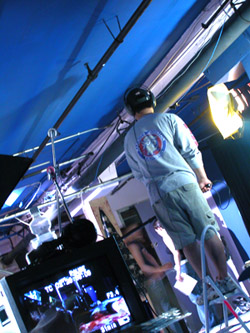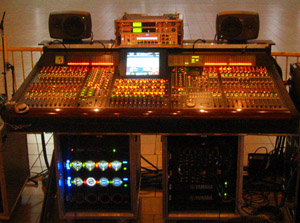

NEVER forget that the piece you are preparing is an audio-visual production. Note that audio comes before visual. It is absolutely vital that you get the sound right for your video - without good sound, your work will look amateurish and sloppy. A slick soundtrack can often hide the cracks in your images. Therefore you need to plan your sound just as carefully as you plan your images.
If your audience is viewing your work via YouTube, the image might be reduced to a couple of inches wide, but the sound will be as big and powerful as their computer speakers - get that to work in your favour, not against you. Video produced for handheld mobile devices needs excellent sound to enhance the storytelling, as images are so small. Sound can help you keep your audience's attention.
There are several different sorts of sound that you can use. Using computer editing software, you can layer them in, adjust volume and sync images to particular sounds. Use 'J-cuts', where you lay in a couple of seconds of sound from one clip over the end of the one before, thus leading the audience into the visuals. You can also use a sound bridge to connect different sequences of images. Some sound you will record using your camera, other sound will come from other sources. Be inventive!
Sound can be divided into two essential areas:
| Diegetic | Generated by things we can see in the picture ('from within the world of the narrative') |
| Non-Diegetic | Generated outside the picture ('from outside the world of the narrative') e.g. voice over or music |
Diegetic sound begins –but doesn't end– with what you record on location at the same time as you capture images. Location sound is often enhanced with sound effects (used to add or heighten individual sounds for narrative effect e.g. a phone ringing, or an explosion off camera). Ambient Sound(outdoors) or Room Tone(indoors) is layered in for realism (and to hide the moment when a plane zoomed overhead or car doors slammed nearby). Dialogue is an important part of diegetic sound, and depends on vocal delivery. A good actor can vary pitch, tone, volume and accent according to what the director wants on set, but an interviewee will only speak in their natural voice. Dialogue can be enhanced in post production, or even replaced as ADR. Sound motifs (e.g. birdsong) can be added as part of post-production sound design, but may seem to come from within the frame.
Raw footage is usually enhanced through the addition of non-diegetic sound, usually in the form of music or voice over.
Adding music to images is an art form. Music creates mood and atmosphere, often by manipulating the emotions experienced while viewing. Music can be classified as either soundtrack or score.
| Soundtrack | Previously-recorded music chosen because of its fit to the rhythm, content and mood of a sequence. If a song, the lyrics may add meaning to the images. |
| Score | Music specifically composed to accompany images. As well as enhancing mood and atmosphere, it can be used thematically - e.g. a character can be represented by a musical theme every time they appear, or the audience can be reminded of a situation every time a musical theme recurs (e.g. the 'shark theme' in JAWS). Music can be discordant or melodic, depending on the desired emotional effect in the viewer. |

You will learn very quickly that, with a video camera, there is no such thing as silence. If you are filming indoors your camera will pick up what is known as 'room noise' - the hum created by electrical appliances (especially air conditioning units!), the buzz of fluorescent lights, the echo of sound waves bouncing off the walls (big rooms sound very different to little rooms), the noises of a building as it creaks gently around you. Professional sound recordists will always record two minutes of so of room tone (with no one talking or moving) as it can come in very useful for patching up a soundtrack. Room noise is deadened by soft furnishing, so if you are seeking to minimize harsh sounds, film in a room with carpets, curtains and lots of soft cushions! You will need to take up the volume to compensate, however.
Outside there is also a lot of background noise, or ambient sound - passing traffic, birdsong, wind, nearby or distant people, aircraft, reversing trucks, squawking sirens - a whole cacophony of sounds that you cannot control. This is the noise of everyday life, and without it images begin to look very odd indeed. You therefore need to record it to add meaning to your filmed sequences, but you need to take care that it is not too loud and that it does not drown out any vital dialogue or voice over. You have some control over volume levels when editing, but it is better to capture your sound effectively at source. It is also worth capturing around two minutes of ambient sound outside as, again, you may need to patch up your soundtrack.
There is a microphone on the front of your camera. Most home video cameras come with an omnidirectional microphone which basically records all the sounds that are present in front of the camera. This means that you must ensure that the dialogue you are trying to capture is much much louder than any background noise. More sophisticated models will also have an external mic jack where you can plug in a more powerful, directional microphone.
Recording human voices is perhaps the most diffculty-fraught area of working in video. Digital video cameras are reasonably good at coping with indoor levels of lighting, however, they are not good at recording sound and this is something you have to work around creatively, especially when interviewing a subject or recording dialogue.
NB - zooming the camera in on a subject does NOT also zoom the microphone.
Remember that you will be cutting back and forth to your b-roll images, and that you can layer your interviewee's comments over different footage. You must prioritise getting good sound. If your interviewee stammers or stumbles over something, or if there is some unavoidable background noise (eg a telephone ringing) wait until the disturbance is over and roll the camera again.
The most efficient way to record a voice over is to find somewhere absolutely quiet (ie with very little room noise - see above) and speak directly into the camera microphone. You can record your own voice overs, or get someone else to act as the "voice" - think carefully about the gender, age and status of your "voice" - all of them will have implications for the meaning of your text.
TIP: Get into bed to record your voiceover - a duvet can deaden all outside noise. Be careful not to wriggle around as rustling sheets are a dead giveaway that you have used this technique.
Sometimes you just have to fake it. Even when working with documentaries, you may need to heighten realism by adding in sound effects at a crucial moment. You can download free sound effects from the following sites, or check out some Sound FX CDs.
Music can totally change the mood of an audio visual piece. Music can make an audience scared, tearful, happy, aware of the seriousness of the situation, or just want to dance! Choose your music carefully - you should aim for relatively short extracts of one song. Think about the mood of that music, its pace (you will have to edit to keep up) and whether it is appropriate to your images. If your music has lyrics it should match the meaning of your images.

Use the fade controls to raise and lower the volume of your music - keep it right down if people are talking. It's best to do your sound mix after your picture edit is final, and, always, use headphones when attempting to set levels. Sometimes subtle background music can be more effective than a pumping beat at the top of the mix (unless you're working on a music video). Think carefully about the in and out points of music. You can use a "J-cut" to bring music in a few seconds before images, to prepare the audience, mood-wise, for what they are about to see.
Try different tracks against some of your footage to see what the effect is. You can transfer a .WAV, .AVI, or .MOV sound file into your computer editing software, but not all of them accept MP3s (which are of lesser quality anyway). Remember, in the real world, there are copyright considerations and your production team would have to pay the holder of the publishing rights to a song; these are often prohibitively expensive, especially for well known songs.